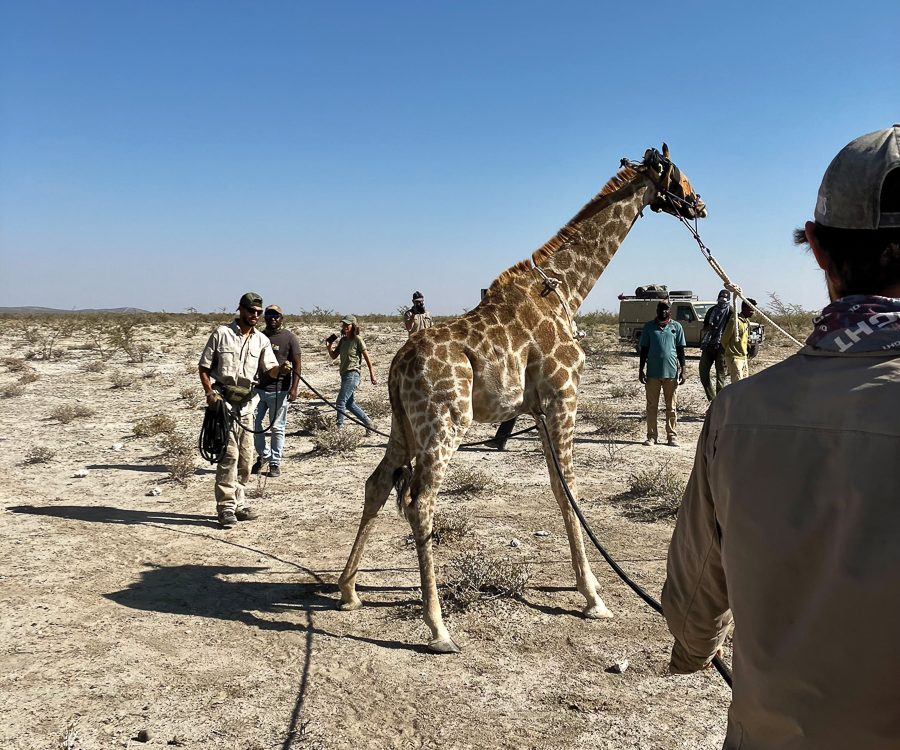Cape Cross – Intrepid explorers, guano and seals
May 21, 2013Walking for lions cross the finishing line
May 22, 2013Text by Marita van Rooyen
“Blue Cranes are critically endangered in Namibia. As with the core population in South Africa, Namibia’s small population of 60 appears to be declining.”
Ann and Mike Scott
Namibia’s cranes and other wetland birds are increasingly vulnerable to the effects of human populations and their habitats, as well as to climate change. Close monitoring is needed to detect changes that require intervention, which is exactly what Mike and Ann Scott had in mind when they started the Crane Working Group in Namibia.
The status of Namibia’s Blue Crane population is a priority of the Crane Working Group. These birds are found mostly in and around the Etosha Pan. Even though they are not essentially water birds, they prefer to breed near water. Following the abundant rains of 2009, the annual wet-season crane survey in Etosha and surroundings once again resulted in questions regarding the disappearance of our crane populations.
“An intensive ground survey and an aerial survey yielded a total of only 11–12 Blue Crane adults and five chicks, all within the park in the areas surrounding the pan.
The aerial survey also produced 11 Wattled Cranes and one Southern Grey Crowned Crane in the Lake Oponono area. As in 2008, this area was extensively and dramatically flooded,” explains Ann. It is likely that the high rainfall and flooding of northern Namibia could account for the missing birds. Still, the drastic dwindling in Blue Crane numbers is puzzling the Namibia Crane Working Group and there have been no answers as of yet. Other major threats to the Blue Crane populations are poisoning, habitat change and power-line collisions.
Originally from South Africa, the Scotts have always had a passion for birds. “We initiated the Namibia Crane Working Group with Chris Brown of the Namibia Nature Foundation (NNF), but since its inception in 2006, we’ve come a long way. We still play a big role in the project, but we’ve passed on a lot of responsibility to the local communities, especially when it comes to the monitoring of birds.”
Mike and Ann were leading important conservation programmes for the benefit of Blue Cranes in the Overberg, South Africa, when they realised (through talks with people such as Chris Brown), that there was a definite need for something similar in Namibia.
“The first Namibia Crane Workshop in Etosha in May 2004 was attended by an enthusiastic mix of participants from Namibia and several other countries. This initiative was a partnership among the NNF, SIDA, the Ministry of Environment and Tourism (MET), the African Wattled Crane Programme (a joint project of the International Crane Foundation and Endangered Wildlife Trust in South Africa) and many other supporters. As a result of concern for the continued survival of Namibia’s crane species and their habitats by workshop participants, we now have a Namibia Crane Action Plan and, equally importantly, a Namibia Crane Working Group (NCWG) to put this plan into action. The working group is currently funded by the GEF Small Grants Project and UNDP, through the NNF.
We need to find ways to promote the protection of this area and Namibia’s small but fascinating Blue Crane population. Contact the Scotts to find out how you can help: e-mail: ecoserve@iway.na
Blue Crane, Anthropoides paradiseus
Text and photos by Pompie Burger
The scientific name of the Blue Crane possibly conjures up images of angels, although of all the cranes occurring in Namibia and Southern Africa, this is probably the least angelic-looking of the three.
The Crowned and Wattled Crane are much more good-looking and angel-like in appearance than the grey-blue Blue Crane. Incidentally, the Grey Crowned Crane – the most spectacular of the three – which used to occur in the northern parts of Namibia, especially on the Andoni plains in Etosha, has almost completely disappeared from the country. Luckily these birds do still occur in Zambia, Zimbabwe and Botswana, and further north.
I was always quite chuffed by the Blue Cranes occurring in Etosha, but after driving through the Overberg in the southern Cape and seeing groups of up to 500 at the same time, I realised they are not that precious or famous. Groups of up to 3 000 have been recorded in the western Cape. Apparently their numbers have increased in range in the Western Cape agricultural areas. In Mpumalanga the different habitats of the different groups vary considerably, with 40% in their natural habitat, 22% at wetlands and 38% in cultivated pastures and croplands.
According to Roberts Birds of Southern Africa, the Blue Cranes are endemic to the Southern African region and are ‘the world’s most range-restricted crane’. Namibian Blue Cranes are, contrary to the Cape population, more localised in their movements, and are found only within the confines of the Etosha National Park. Their diet consists of bulbs, seeds, roots insects, worms, crabs, fish, frogs, crabs and reptiles, so they understandably feel quite comfortable in almost any habitat, although studies reveal that the contents of their stomachs consist mainly of seeds and vegetable matter, probably the reason why they haven’t adopted the Namibian way of living off meat for breakfast, lunch and dinner.
FLAMINGO January 2010





